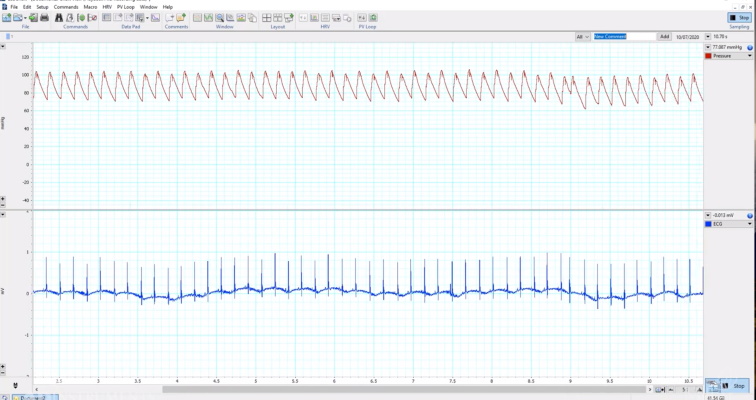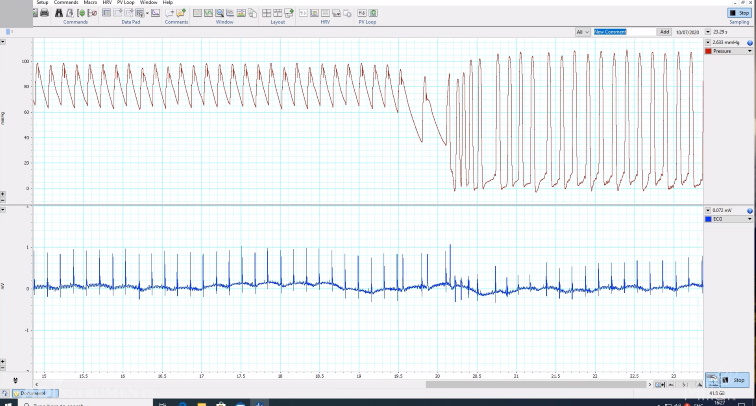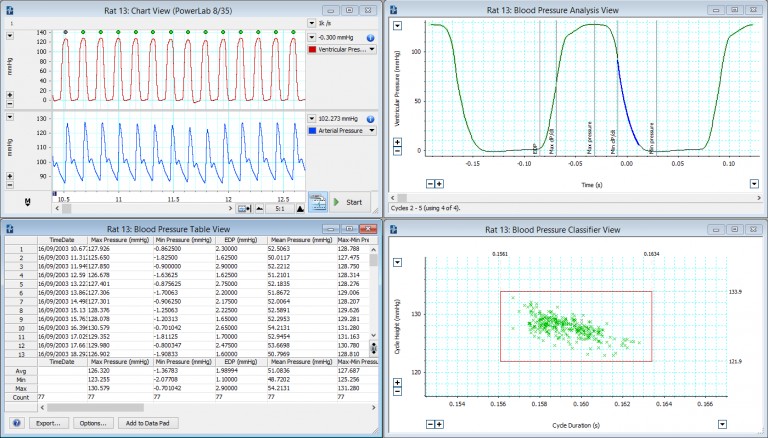Left Ventricular Pressure via Carotid in Mouse
Instructions for carotid artery catheterization using a Millar 1-French catheter
for left ventricular pressure measurement in mice.
Surgery performed at the René Remie Surgical Skills Centre by Prof. René Remie. Animal handling and surgical procedures all strictly follow Dutch Legislation on Laboratory Animals and was approved by the IACUC.
Hardware:
- ADInstruments PowerLab 16/35 for data acquisition
- Animal BioAmp for ECG measurement
- Bridge Amp for Pressure measurement
Catheter:
- The Millar SPR-1000 catheter is connected to the Bridge Amp
Software used to record and analyze the pressure signal:
Anesthetic:
The mouse was anesthetized using injectable anesthetics and analgesics.
Procedure:
Make a simple catheter introducer
Before you begin the surgery, you can follow our step by step video instructions for making a simple catheter introducer from a 27 gauge syringe needle.
- With the bevel of the needle facing upwards, bend the tip almost 90 degrees using a needle holder.
- You can also bend the needle a little to one side to prevent your fingers from being in the field of view when performing the catheterization.
- Attach the needle onto a syringe to create a simple catheter introducer.
Procedure begins: Incision
- Make an incision from the level of the eyes to just above the sternum.
- Holding the tissue in the rostral direction, first make a small incision, and then using the tissue holder and scissors, extend the incision along the neck.
- Cut through the connective tissue and use blunt dissection to clear away between the submandibular glands.
- Maneuver between the two glands, spreading them using blunt dissection, until the sternohyoid muscle comes into view.

Tip: Do not use scalpel blades as they can cause an enormous amount of blood loss.
This can be detrimental to the animal, especially a mouse.
Find the carotid artery
Once the tissue has been cleared away, you will be able to identify three muscles. Between the glands is the sternohyoid muscle. You will also be able to see the sternomastoid muscle, and lower down, the digastric muscle. These three muscles form a triangle. Inside this triangle, you will find the carotid artery.
Access the carotid via the following steps:
- Using forceps you can spread away the sternohyoid from the sternomastoid muscle.
- Place a hook to move the sternomastoid muscle out of the way.
- Use a second hook to move the submandibular gland out of the way.
- Using a hook on the other side, move the sternohyoid muscle out of the way, to reveal as much of the carotid artery as possible.
- Using blunt dissection, remove as much of the tissue around the artery as possible.
- You can place a fourth hook if you need to get better access to the artery.
- You will notice the hypoglossal nerve, which indicates that you are near the carotid artery bifurcation. [See video at 05:23]
- If necessary, move the hooks.
Separate the vagus nerve from the carotid artery
- Very carefully open the perivascular sheath.
- Using blunt dissection make sure the vessel is separated from the nerve.
- Make sure the vessel and nerve are separated with enough length to allow for the tying off of the vessel.
Ligature
First, place the obstructive ligature.
- Make sure that the nerve is free from the vessel. Otherwise, there is the risk that you will tie the nerve together with the vessel in the ligature, which can cause erratic heart rates.
- Zoom out one step of the microscope to facilitate tying the knot.
- Move the ligature as far rostrally as possible.
- Complete the knot.
- Add a drop of saline to the vessel to prevent it from drying out. It is interesting to note that a mouse can have 40 to 80 microlitres of insensible fluid loss per hour due to exposed tissue. For this reason, it is also advisable to counter this with a saline line in the left jugular vein for long term recordings.
- Next, place tension on the obstructive ligature by using some artery forceps.
Place the second ligature.
- Place a second ligature, which will be used to tie off around the catheter.
- Only tie half a knot and place the strands so that they are easily grasped when the catheter has been inserted.
Place a third ligature as a safety.
- A third ligature, or safety ligature, can be placed. This is not always necessary, but a good idea if you’re starting out with this technique, as it can be used to stop bleeding, should this occur at the second ligature.
- Again, move the hooks if it will give you better access to the vessel.
Arrange the ligatures so that they are easily accessible.
Next, place the clamp.
- For this, a narrow jawed venous clamp will be used, also known as a Biemer clamp. Its closing force is high enough to occlude the artery in a mouse.
Insert the catheter
- Throughout this procedure regularly moisten the artery with some saline, as this will improve insertion of the catheter.
- Increase magnification

Tip: To hold the catheter in place, use forceps where the tips have been covered with silicon tubing. This will protect the catheter.
- To insert the catheter, puncture a hole using the catheter introducer, as close as possible to the obstructive ligature.
- Place the catheter under the needle and advance it into the artery as far as the clamp.
- You can now tie off the first ligature, around the vessel and catheter. Be sure not to over tighten it, but just enough to prevent bleeding.
- With one hand holding the catheter, use your other hand to slowly remove the clamp, checking for any leaks.
Should it leak, just re-place the clamp and determine where the leak is.
If there is no leak, advance the catheter towards the heart using the forceps with silicon tubing covered ends. - With the catheter in the artery, you can see the signal in LabChart (or your own software) where the dicrotic notch is clearly visible:

- As you advance the catheter it will eventually reach the heart. When it reaches the aortic valve, the catheter and vessel will move quite vigorously. [See video at 14.25]
- You can now tie off the safety ligature. Not too tight as this will prevent moving the catheter into the ventricle.
- When you advance the catheter past the aortic valve, the LabChart trace will change from systemic pressure into ventricular pressure (in this case, between just above zero and 100mmHg). This means you are in the ventricle.


Tips:
- When doing a long term recording, it’s a good idea to tie off the extra ligature in case the second ligature has moved, or the vessel has been damaged due to the movement of the catheter.
- Use the obstruction ligature ends to tie off the catheter with another knot, so as to hold the catheter securely in place. In doing so, the catheter is held in 3 places and this will prevent it from moving.
- Try not to make your sutures longer than 4cm as it will make it difficult to find the suture ends under a microscope.
Completion of procedure
Finally, clean up the wound and remove the hooks. For long term recordings, a piece of gauze moistened with saline can be placed on top to prevent fluid loss.
We hope you found these surgical instructions useful.
Please visit our comprehensive Invasive Blood Pressure Application page for specialized information and useful resources relating to invasive blood pressure applications and research.
If you have any questions, please contact your ADInstruments support representative who will be happy to provide specific information and assistance with your research requirements.
Return to Surgical Instruction Video Series Main Page »
Additional resources
- Optimizing your Blood Pressure and Pressure-Volume Recordings »
- Cardiovascular Assessment of Pressure-Volume and Blood Pressure »
- Invasive Blood Pressure - fundamentals and best practices for preclinical research »
- Troubleshooting your Millar Catheter: Three common problems and how to fix them »
Find out more about Invasive Blood Pressure recording and analysis:
Everything you need for invasive blood pressure recording and analysis, in one place »
